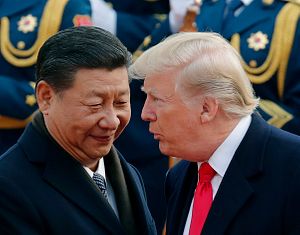The usual cast of characters were back at the negotiating table, trying to find a way to stem another round of U.S. tariff increases that were stayed in December after the Buenos Aires G20 meeting between U.S. President Donald Trump and Chinese President Xi Jinping.
U.S. Treasury Secretary Steven Mnuchin and Trade Representative Robert Lighthizer were back in Beijing, where they again sat across the table from Vice-Premier Liu He, China’s lead trade negotiator. The U.S. delegation also met Xi himself at the end of the talks on Friday.
Both nations said they had made progress to settle their disputes, but admitted there were still difficult issues to deal with. Negotiators will continue the talks in Washington next week.
The stakes are clear and the clock is ticking. The two sides need to arrive at an understanding by March 2, the day on which Trump has said he will move forward with an increase in tariffs.
At least that was the idea. In recent days, Trump has made multiple remarks that suggest the March deadline is anything but absolute. He has hinted he would be open to pushing it back if he sensed that a deal was around the corner. Reports have even suggested the White House is considering another 60-day extension of the tariff truce.
“They’re showing us tremendous respect,” Trump said of China’s attitude in the negotiations, adding that talks were “going along very well”. With Trump slated to travel to Asia at the end of the month for a second summit with North Korean leader Kim Jong-un in Hanoi, the prospect of a second meeting between him and Xi – right before the anticipated deadline – is very real.
What’s slowly slipping through the cracks in this process is a sustainable and long-term agreement on structural reform in China, which is what’s been at the centre of the Trump administration’s trade grievances.
Already articulated U.S. concerns cover a broad range of Chinese practices. The ideal short-term measures the American side would like to see include unconditional market access for U.S. firms in China; a less insulated environment for state-owned enterprise decision making; greater regulatory transparency; and fairer legal protections for American businesses in China.
As with so many aspects of the Trump administration’s foreign policy, the U.S. president’s personality is taking over the process, leaving his deputies who are doing the negotiating in a disadvantageous position. For China, the obvious answer then becomes not to discuss the nuances of what kinds of structural reform might be necessary with Lighthizer, but to simply get Xi in the room with Trump.
This mirrors the lesson that North Korea’s Kim has taken away over the course of nearly a year of negotiations with the U.S.. Instead of expending any serious diplomatic capital in a detail oriented negotiation with the secretary of state or the president’s special representative, the key is to simply meet Trump and work out high-level arrangements mano a mano.
In this climate, we can’t expect a real resolution on the core issues. Everything from American misgivings about Beijing’s interventionist industrial policies that protect Chinese enterprises to broader structural shifts in the nature of the U.S.-China economic relationship since the turn of the century are on the table today – and they’ll stay there.
Xi and Trump may well find a temporary way out of the impasse, giving global investors the runway necessary to avert the panic that would likely ensue if the U.S. pushed ahead with a tariff increase on U.S.$200 billion in Chinese goods. Even if China doesn’t quite give the United States a down payment on structural reforms, Xi can promise Trump that he will chip away at the trade deficit while leaving untouched the issues that a more detail oriented negotiator like Lighthizer might zero in on.
If there is a “win-win” outcome here, it would be for Trump and Xi to find an agreeable arrangement that would allow the U.S. president to walk away looking tough to his base while leaving China’s core, long-term industrial policy trajectory unharmed. That would strip away any remaining negotiating leverage the U.S. side might have within the trade war, and it’s not unlikely.
This article first appeared at the South China Morning Post. It is republished here with kind permission.
































